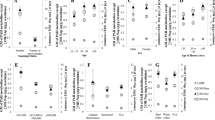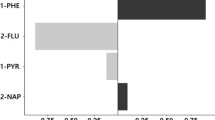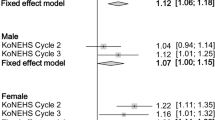Abstract
Urinary 1-hydroxypyrene (1-OHP) has been suggested as an exposure biomarker for polycyclic aromatic hydrocarbons (PAHs). However, it remains unknown whether a first morning urine sample can be used to reflect average exposure. In this paper, we examine intra-individual differences and inter-individual associations between first morning voids and 24-h composite urine samples. The analysis was performed using data collected from 100 adults who had a wide range of PAH exposure due to differences in their occupation, e.g., coke oven workers vs. non-coke oven workers. For each subject, all the urine voids within each of two 24-h measurement periods were collected. Results showed a significant (40% to 62%) intra-individual difference between first morning voids and 24-h urinary 1-OHP concentrations (in ng/ml urine). Creatinine adjustments of 1-OHP concentrations (in μmol/mol urinary creatinine) reduced the intra-individual difference by approximately 10%. Across all the subjects, a high overall correlation (r=0.76) was observed between first morning and 24-h average 1-OHP concentrations. Work environment and sampling season were found to significantly affect the relationship between first morning and 24-h 1-OHP concentrations. An increase of 1 ng/ml of first morning urinary 1-OHP predicted an increase of 0.5 and 0.25 ng/ml of 24-h urinary 1-OHP for coke oven workers and non-coke oven workers, respectively. Data collected in a winter season showed a higher correlation between first morning and 24-h concentrations than data collected in a fall season. Creatinine adjustments did not significantly improve overall correlations between first morning void and 24-h measurements, but increased total variances for 24-h urines explained by first morning urines in coke workers.
This is a preview of subscription content, access via your institution
Access options
Subscribe to this journal
Receive 6 print issues and online access
$259.00 per year
only $43.17 per issue
Buy this article
- Purchase on Springer Link
- Instant access to full article PDF
Prices may be subject to local taxes which are calculated during checkout


Similar content being viewed by others
References
Angerer J., Mannschreck C., and Gundel J. Biological monitoring and biochemical effect monitoring of exposure to polycyclic aromatic hydrocarbons. Int Arch Occup Environ Health 1997: 70 (6): 365–377.
Barr D.B., Wilder L.C., Caudill S.P., Gonzalez A.J., Needham L.L., and Pirkle J.L. Urinary creatinine concentrations in the US population: implications for urinary biologic monitoring measurements. Environ Health Perspect 2005: 113 (2): 192–200.
Boeninger M.F., Lowry L.K., and Rosenberg J. Interpretation of urine results used to assess chemical exposure with emphasis on creatinine adjustments: a review. Am Ind Hyg Assoc J 1993: 54: 615–627.
Boogaard P.J., and van Sittert N.J. Exposure to polycyclic aromatic hydrocarbons in petrochemical industries by measurement of urinary 1-hydroxypyrene. Occup Environ Med 1994: 51 (4): 250–258.
Bouchard M., Krishnan K., and Viau C. Kinetics of tissue distribution and elimination of pyrene and 1-hydroxypyrene following intravenous administration of [14C]pyrene in rats. Toxicol Sci 1998: 46 (1): 11–20.
Bouchard M., Pinsonneault L., Tremblay C., and Weber J.P. Biological monitoring of environmental exposure to polycyclic aromatic hydrocarbons in subjects living in the vicinity of a creosote impregnation plant. Int Arch Occup Environ Health 2001: 74 (7): 505–513.
Buckley T.J., and Lioy P.J. An examination of the time course from human dietary exposure to polycyclic aromatic hydrocarbons to urinary elimination of 1-hydroxypyrene. Br J Ind Med 1992: 49 (2): 113–124.
Chuang J.C., Callahan P.J., Lyu C.W., and Wilson N.K. Polycyclic aromatic hydrocarbon exposures of children in low-income families. J Expo Anal Environ Epidemiol 1999: 9 (2): 85–98.
Fiala Z., Vyskocil A., Krajak V., Viau C., Ettlerova E., and Bukac J., et al. Environmental exposure of small children to polycyclic aromatic hydrocarbons. Int Arch Occup Environ Health 2001: 74 (6): 411–420.
Garde A.H., Hansen A.M., Kristiansen J., and Knudsen L.E. Comparison of uncertainties related to standardization of urine samples with volume and creatinine concentration. Ann Occup Hyg 2004: 48 (2): 171–179.
Grimmer G., Dettbarn G., and Jacob J. Biomonitoring of polycyclic aromatic hydrocarbons in highly exposed coke plant workers by measurement of urinary phenanthrene and pyrene metabolites (phenols and dihydrodiols). Int Arch Occup Environ Health 1993: 65 (3): 189–199.
Hines C.J., Deddens J.A., Striley C.A.F., Biagini R.E., Shoemaker D.A., and Brown K.K., et al. Biological monitoring for selected herbicide biomarkers in the urine of exposed custom applicators: application of mixed-effects models. Ann Occup Hyg 2003: 47 (6): 503–517.
Hinwood A.L., Sim M.R., de Klerk N., Drummer O., Gerostamoulos J., and Bastone E.B. Are 24-h urine samples and creatinine adjustment required for analysis of inorganic arsenic in urine in population studies? Environ Res 2002: 88 (3): 219–224.
Jongeneelen F.J., van Leeuwen F.E., Oosterink S., Anzion R.B., van der Loop F., and Bos R.P., et al. Ambient and biological monitoring of cokeoven workers: determinants of the internal dose of polycyclic aromatic hydrocarbons. Br J Ind Med 1990: 47 (7): 454–461.
Jongeneelen F.J. Benchmark guideline for urinary 1-hydroxypyrene as biomarker of occupational exposure to polycyclic aromatic hydrocarbons. Ann Occup Hyg 2001: 45 (1): 3–13.
Jongeneelen F.J. Biological monitoring of environmental exposure to polycyclic aromatic hydrocarbons; 1-hydroxypyrene in urine of people. Toxicol Lett 1994: 72 (1–3): 205–211.
Keimig S.D., Kirby K.W., Morgan D.P., Keiser J.E., and Hubert T.D. Identification of 1-hydroxypyrene as a major metabolite of pyrene in pig urine. Xenobiotica 1983: 13 (7): 415–420.
Kim J.Y., Hecht S.S., Mukherjee S., Carmella S.G., Rodrigues E.G., and Christiani D.C. A urinary metabolite of phenanthrene as a biomarker of polycyclic aromatic hydrocarbon metabolic activation in workers exposed to residual oil fly ash. Cancer Epidemiol Biomarkers Prev 2005: 14 (3): 687–692.
Kissel J.C., Curl C.L., Kedan G., Lu C., Griffith W., and Barr D.B., et al. Comparison of organophosphorus pesticide metabolite levels in single and multiple daily urine samples collected from preschool children in Washington State. J Expo Anal Environ Epidemiol 2005: 15: 164–171.
Kuljukka T., Vaaranrinta R., Mutanen P., Veidebaum T., Sorsa M., and Kalliokoski P., et al. Assessment of occupational exposure to PAHs in an Estonian coke oven plant — correlation of total external exposure to internal dose measured as 1-hydroxypyrene concentration. Biomarkers 1997: 2: 87–94.
Levin J.O., Rhen M., and Sikstrom E. Occupational PAH exposure: urinary 1-hydroxypyrene levels of coke oven workers, aluminium smelter pot-room workers, road pavers, and occupationally non-exposed persons in Sweden. Sci Total Environ 1995: 163 (1–3): 169–177.
Madhavan N.D., and Naidu K.A. Polycyclic aromatic hydrocarbons in placenta, maternal blood, umbilical cord blood and milk of Indian women. Hum Exp Toxicol 1995: 14 (6): 503–506.
McClean M.D., Rinehart R.D., Ngo L., Eisen E.A., Kelsey K.T., and Wiencke J.K., et al. Urinary 1-hydroxypyrene and polycyclic aromatic hydrocarbon exposure among asphalt paving workers. Ann Occup Hyg 2004: 48 (6): 565–578.
Motykiewicz G., Michalska J., Pendzich J., Malusecka E., Strozyk M., and Kalinowska E., et al. A molecular epidemiology study in women from Upper Silesia, Poland. Toxicol Lett 1998: 96–97: 195–202.
Mucha A.P., Hryhorczuk D., Serdyuk A., Nakonechny J., Zvinchuk A., and Erdal S., et al. Urinary 1-hydroxypyrene as a biomarker of PAH exposure in 3-year-old Ukrainian children. Environ Health Perspect 2006: 114 (4): 603–609.
Ovrebø S., Haugen A., Hemminki K., Szyfter K., Drabløs P.A., and Skogland M. Studies of biomarkers in aluminum workers occupationally exposed to polycyclic aromatic hydrocarbons. Cancer Detect Prev 1995: 19 (3): 258–267.
Pan G., Hanaoka T., Yamano Y., Hara K., Ichiba M., and Wang Y., et al. A study of multiple biomarkers in coke oven workers—a cross-sectional study in China. Carcinogenesis 1998: 19 (11): 1963–1968.
Que Hee S.S. Biological Monitoring: an Introduction. Van Norstrand Reinhold, New York, 1993.
Scher D.P., Alexander B.H., Adgate J.L., Eberly L.E., Mandel J.S., and Acquavella J.F., et al. Agreement of pesticide biomarkers between morning void and 24-h urine samples from farmers and their children. J Expo Sci Environ Epidemiol 2007: 17 (4): 350–357.
Serdar B., Waidyanatha S., Zheng Y., and Rappaport S.M. Simultaneous determination of urinary 1- and 2-naphthols, 3- and 9-phenanthrols, and 1-pyrenol in coke oven workers. Biomarkers 2003: 8 (2): 93–109.
Siwinska E., Mielzynska D., Smolik E., Bubak A., and Kwapulinski J. Evaluation of intra- and interindividual variation of urinary 1-hydroxypyrene, a biomarker of exposure to polycyclic aromatic hydrocarbons. Sci Total Environ 1998: 217 (1–2): 175–183.
Somogyi A., and Beck H. Nurturing and breast-feeding: exposure to chemicals in breast milk. Environ Health Perspect 1993: 101 (Suppl 2): 45–52.
Unwin J., Cocker J., Scobbie E., and Chambers H. An assessment of occupational exposure to polycyclic aromatic hydrocarbons in the UK. Ann Occup Hyg 2006: 50 (4): 395–403.
Viau C., Lafontaine M., and Payan J.P. Creatinine normalization in biological monitoring revisited: the case of 1-hydroxypyrene. Int Arch Occup Environ Health 2004: 77 (3): 177–185.
WHO. Biological Monitoring of Chemical Exposure in the Workplace. Vol. 1 World Health Organization, Geneva, 1996.
Wu M.T., Mao I.F., Ho C.K., Wypij D., Lu P.L., and Smith T.J., et al. Urinary 1-hydroxypyrene concentrations in coke oven workers. Occup Environ Med 1998: 55 (7): 461–467.
Acknowledgements
We thank all the study participants and our co-workers at Anshan Environmental Monitoring Center, Anshan Iron and Steel Company, and UMDNJ, who participated in the collection of original data. We also thank Dr. Dana Barr at CDC for her useful suggestions during the preparation of this manuscript. The original data collection was funded by a grant from the National Cancer Institute to UMDNJ (1R21-CA94743 -01). Drs. Zhang and Rhoads are in part supported by NIEHS Center grant to UMDNJ (P30 ES05022).
Author information
Authors and Affiliations
Corresponding author
Rights and permissions
About this article
Cite this article
Han, IK., Duan, X., Zhang, L. et al. 1-Hydroxypyrene concentrations in first morning voids and 24-h composite urine: intra- and inter-individual comparisons. J Expo Sci Environ Epidemiol 18, 477–485 (2008). https://doi.org/10.1038/sj.jes.7500639
Received:
Accepted:
Published:
Issue Date:
DOI: https://doi.org/10.1038/sj.jes.7500639
Keywords
This article is cited by
-
Hair analysis for the biomonitoring of polycyclic aromatic hydrocarbon exposure: comparison with urinary metabolites and DNA adducts in a rat model
Archives of Toxicology (2018)
-
Effects of profession on urinary PAH metabolite levels in the US population
International Archives of Occupational and Environmental Health (2016)
-
Urinary 1-hydroxypyrene concentration as an exposure biomarker to polycyclic aromatic hydrocarbons (PAHs) in Mexican women from different hot spot scenarios and health risk assessment
Environmental Science and Pollution Research (2016)
-
Cancer risk of petrochemical workers exposed to airborne PAHs in industrial Lanzhou City, China
Environmental Science and Pollution Research (2015)
-
Polycyclic aromatic hydrocarbons: determinants of urinary 1-hydroxypyrene glucuronide concentration and risk of colorectal cancer in the Shanghai Women’s Health Study
BMC Cancer (2013)



